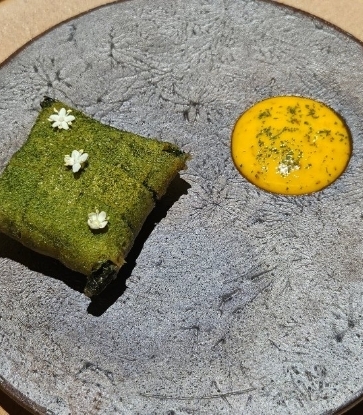Lined with one elegant boutique after another, Ginza is Japan’s most fashionable high-street area. Particularly exclusive is Namiki-dori Street in Ginza 5-chome, which catches the eye with its granite footpaths, and which is where Tempura Kondo is found. It is said that only a handful of businesses can succeed in Ginza, yet Fumio Kondo has wielded his pans for over 30 years, managing a restaurant that draws rapt attention from throughout Japan and around the world. Even today, Kondo continues to take tempura in fascinating new directions. What drives him to pursue this lifelong quest?

Fumio Kondo was born in Tokyo in 1947. Upon graduating from high school, Kondo landed a job at Tokyo’s Hilltop Hotel. He trained in Japanese cuisine and was selected as a master chef at the age of 23. At a time when seafood wrapped in thick batter was the prevailing style of tempura, Kondo challenged convention with lightly-battered tempura creations of colourful vegetables in season. Literary figures and celebrities in every field adored his work. In 1991, at the age of 43, he opened Tempura Kondo in Ginza. In 2019, in recognition of his many years of culinary leadership, the Japanese government named Kondo a Contemporary Master Craftsman, making him the first tempura chef so honoured.

Spreading Tempura to the World
From its core lexicon of fish and shellfish, Kondo extended the language of tempura to include seasonal vegetables deep-fried in light batter. With this innovation, Fumio Kondo showcased the possibilities for edomae tempura in the modern age. His decision to open his own restaurant at the age of 43 was motivated by a desire to pursue the possibilities of tempura freely, unfettered by convention, and spread its joys to a worldwide audience.The renowned photographer Ken Domon gave Kondo a piece of his own calligraphy, inscribed with the single Japanese character aji, ‘flavour’. Aji is a combination of two simpler characters, ‘mouth’ and ‘future’. This, Kondo believes, is because cuisine must not only be delicious but also inspire passion for what is to come; in short, it must also be beautiful. This insight is the point of departure for the original and beautiful tempura Kondo creates.
Kondo does not hesitate to publish recipes if it will further the tempura movement. Cooking techniques are generally regarded as proprietary information, not to be shared with outsiders, but Kondo begs to differ: ‘Tempura cuisine will never catch on with that attitude. If other restaurants use the same techniques, we just have to step up our efforts to compete’.


©Tempura Kondo
‘I’m only 80% of the chef I want to be’
Kondo recalls that at age 65, after many years of hard work, and with his debts finally paid off, he was considering retirement. Whenever his heart felt troubled, he said, he would retreat to one particular room in his house, where he displayed the calligraphy and letters sent to him by famous people who had dined at his restaurant. On one such day, says Kondo, he felt that they were telling him that he had only attained 80% of his potential. He realized that he still had much to do, including training the next generation and advancing the tempura movement, to live up to the remaining 20%. The tempura master began making media appearances and publishing books, all to spread the word about the wonders of tempura. He sees himself as a link to the future. It is vital, he shares, to continue labouring humbly, showing the younger generation a good example of continuously tackling fresh challenges. ‘Don’t let yourself get conceited’, Kondo encourages up-and-coming chefs. ‘Keep giving it everything you’ve got. And you must express your individuality’.
Kondo’s Bonds with the Family and Staff Who Support Him
Takahiro Kitagawa joined Tempura Kondo at the age of 19 and has been working at the restaurant for 30 years. Asked for his impression of his mentor, Kitagawa says Kondo is a humble, modest man who treats everyone the same. Usually, observes Kitagawa, as people become famous and their position in society rises, they become arrogant to those around them. But, he says, Kondo’s attitude toward Kitagawa has not changed a whit from the time he joined the restaurant to the present day. ‘He’s a hard act to follow’, Kitagawa remarks with admiration.Taking charge of the back counter is Kondo’s eldest son, Masahiko. What Masahiko especially admires about his father is the attentive care he shows to each customer. He keeps an eye on every movement, never missing a single reaction, says Masahiko. A single gesture can tell him what the customer is thinking, and a cook imparts his feelings to the tempura the moment he fries it. Watching from the background as his father works his magic, Masahiko has learned by watching how his father maintains his presence of mind at all times, never changing his temperament when he has a pan in front of him. ‘I want to uphold what we’ve built here at Tempura Kondo while keeping an eye on the wider world’, Masahiko says, sharing his aspirations for the future.
Throughout his career, Kondo has enjoyed the loving support of his wife Harumi. Looking back on the earliest days of the restaurant, Harumi recalls that they opened in 1991, the very year that Japan’s asset-inflation bubble burst. Rents were sky-high in Ginza, yet the newly-opened restaurant saw little foot traffic for days on end. With small children to feed, Harumi felt somewhat uneasy about the shop’s scant turnover. Yet she never lost her unshakable confidence that one day Tempura Kondo would succeed. Today she explains cheerfully that she believed in her husband’s talents as a manager, a man who could see beyond the present difficult circumstances and plan five or ten years ahead. These heartfelt words of support speak to the depth of the bond between the two.


Keeping Thoughts of his Mentor, Shotaro Ikenami, in his Heart
If you look at the restaurant’s cooking uniforms, you will notice that ‘Tempura Kondo’ is embroidered on the left breast in a vigorous calligraphic style. When we asked about this, Kondo explained that, before his passing in 1990, Naoki Prize–winning novelist Shotaro Ikenami had written his restaurant’s name in exactly this way in a letter to him. ‘Ikenami didn’t live to see me open my own restaurant, so I asked his widow if I could use his calligraphy as a tribute to him. Smiling, he added, ‘I like to think that he’s happy for me, looking down at me and saying, ”Kon-chan, you did well”.’ We are quite sure that Kondo’s mentor is proudly watching over the life with tempura he has achieved.
What Michelin Means to Fumio Kondo
‘The Michelin Guide created the art of restaurant rating’, affirmed Kondo. ‘Having a Michelin star is a reason to strive to do even better. We cannot afford to get complacent now. If we start resting on our laurels, we might as well just quit. But we will meet any challenge. And that is the spirit that will let our star shine even brighter.’
Kondo prays for the success of the tempura movement with a modest spirit and a grateful heart. His genial personality strikes a chord with diners, who come to his restaurant in large numbers. Fumio Kondo is 75 years old, but he plans to keep up the good fight, looking to clinch that remaining 20%.
Related Restaurants:
Tempura Kondo
MICHELIN Guide Tokyo 2022 Tempura restaurants
Related Pages:
MICHELIN Guide Tokyo 2022 is Unveiled Today, with 432 Selected Restaurants


















